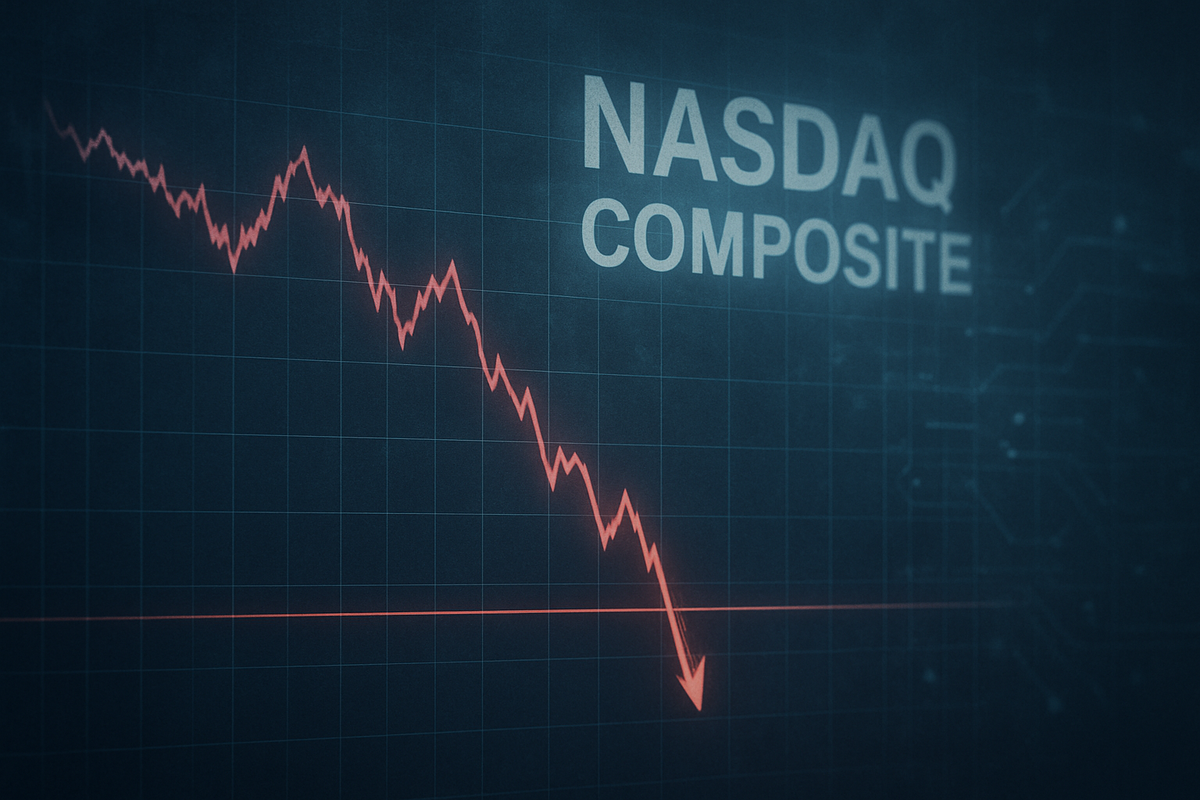
The Nasdaq Composite experienced a significant downturn today, November 11, 2025, as investor anxieties over persistent inflation and the prospect of aggressive interest rate hikes by the Federal Reserve reached a fever pitch. The tech-heavy index saw a broad sell-off, marking a stark reminder of the market's sensitivity to macroeconomic pressures and the valuations of high-growth technology companies. This stumble has sent ripples across the market, prompting concerns about the sustainability of the recent tech rally and the broader economic outlook.
The immediate implications are a heightened sense of caution among investors, with many re-evaluating their positions in growth-oriented assets. The downturn reflects a shift in market sentiment, moving away from speculative growth and towards more stable, value-oriented investments, as the cost of capital is expected to rise.
A Day of Reckoning for Tech
Today's market action saw the Nasdaq Composite close down by over 3%, erasing significant gains made earlier in the year. The sell-off was widespread, impacting a diverse range of technology and growth stocks, from established giants to emerging innovators. The catalyst for this sharp decline appeared to be the release of unexpectedly high Consumer Price Index (CPI) data for October, which showed inflation remaining stubbornly elevated, far exceeding market expectations. This data immediately fueled speculation that the Federal Reserve would be compelled to adopt a more hawkish stance, potentially implementing more aggressive interest rate increases than previously anticipated to curb inflationary pressures.
The timeline of events leading to this moment began weeks ago with a series of hawkish statements from various Federal Reserve officials, signaling a strong commitment to bringing inflation under control. These statements, combined with a tightening labor market and persistent supply chain disruptions, had already set a nervous tone. However, today's CPI report served as the tipping point, causing a cascade of sell orders. Key players and stakeholders involved include institutional investors, hedge funds, and retail traders, all reacting swiftly to the new economic data. Initial market reactions were characterized by a flight to safety, with investors moving into bonds and defensive stocks, while the tech sector bore the brunt of the selling pressure. The VIX volatility index, often referred to as the market's fear gauge, surged significantly, reflecting increased uncertainty.
Shifting Sands: Winners and Losers in a Volatile Market
The Nasdaq's stumble inevitably creates a clear delineation between potential winners and losers in the current market environment. On the losing side are predominantly high-growth technology companies, particularly those with high valuations predicated on future earnings growth. Companies like Apple (NASDAQ: AAPL), Microsoft (NASDAQ: MSFT), and Amazon (NASDAQ: AMZN), despite their robust fundamentals, saw their stock prices decline as investors recalibrated their discount rates for future cash flows in anticipation of higher interest rates. Smaller, unprofitable tech startups that rely heavily on venture capital and easy access to cheap financing are particularly vulnerable, as a tighter monetary policy environment makes capital more expensive and harder to secure. Many software-as-a-service (SaaS) companies, which have enjoyed premium valuations, are also facing downward pressure as their long-duration assets become less attractive.
Conversely, sectors and companies traditionally viewed as defensive or value-oriented could emerge as relative winners. Financial institutions, such as major banks like JPMorgan Chase (NYSE: JPM) and Bank of America (NYSE: BAC), often benefit from rising interest rates as their net interest margins expand. Energy companies, like ExxonMobil (NYSE: XOM), and utilities, such as NextEra Energy (NYSE: NEE), which provide essential services and often pay dividends, tend to perform better during periods of economic uncertainty and inflation. Additionally, consumer staples companies like Procter & Gamble (NYSE: PG), known for stable demand regardless of economic cycles, may see increased investor interest. This market rotation signifies a strategic shift by investors seeking stability and immediate returns over long-term growth prospects.
Broader Implications and Historical Context
Today's Nasdaq stumble is not an isolated event but rather fits into a broader industry trend of re-evaluating growth stock valuations in a rising interest rate environment. For much of the past decade, low interest rates provided a fertile ground for technology companies to flourish, enabling them to fund aggressive expansion and achieve high valuations. However, as central banks around the world grapple with persistent inflation, that era of cheap money appears to be drawing to a close. This event could trigger ripple effects across the entire technology ecosystem, impacting startups seeking funding, venture capital firms, and even the broader mergers and acquisitions (M&A) landscape. Companies reliant on advertising revenue, like Meta Platforms (NASDAQ: META) and Alphabet (NASDAQ: GOOGL), might also face headwinds if a tighter economic environment leads to reduced corporate spending.
Regulatory bodies and policymakers will be closely watching these market movements. A significant and prolonged downturn in the tech sector could prompt discussions about market stability and potential interventions, although direct regulatory action is unlikely in the short term. Historically, periods of rapid technological innovation followed by market corrections are not uncommon. The dot-com bubble burst of 2000 serves as a stark precedent, demonstrating how speculative fervor can be tempered by economic realities. While the current situation differs significantly in terms of underlying company fundamentals and market maturity, the underlying principle of investors re-evaluating valuations in response to changing economic conditions remains constant. This event underscores the cyclical nature of markets and the importance of adapting investment strategies to evolving macroeconomic landscapes.
Navigating the Path Ahead
Looking ahead, the short-term possibilities for the Nasdaq Composite include continued volatility and potentially further declines if inflation persists and the Federal Reserve signals even more aggressive tightening. Investors will be scrutinizing upcoming economic data, particularly inflation reports and employment figures, for any signs of moderation that could alleviate pressure on the central bank. In the long term, however, the underlying innovation and growth potential of many technology companies remain strong. This period of correction could present strategic opportunities for well-capitalized companies to acquire undervalued assets or for investors to accumulate shares in fundamentally sound companies at more attractive valuations.
Potential strategic pivots required for tech companies might include a renewed focus on profitability over pure growth, more disciplined capital allocation, and a greater emphasis on generating free cash flow. Companies that can demonstrate resilience and adaptability in a higher interest rate environment will be best positioned to thrive. Market opportunities may emerge in sectors that benefit from inflation, such as commodities, or in companies with strong pricing power and robust balance sheets. Challenges include increased cost of capital, potential slowdowns in consumer and enterprise spending, and a more competitive environment for attracting and retaining talent. Potential scenarios range from a relatively quick market rebound if inflation cools faster than expected, to a more prolonged period of sideways trading or even a deeper correction if economic conditions deteriorate further.
A Prudent Path Forward
Today's stumble on the Nasdaq Composite serves as a critical reminder of the dynamic interplay between macroeconomic forces and equity markets. The key takeaway is that the era of ultra-low interest rates, which significantly fueled tech sector growth, is giving way to a more normalized monetary policy environment. Investors must assess the market moving forward with a keen eye on inflation trends, central bank communications, and corporate earnings reports. The market's reaction underscores the importance of diversification and a balanced portfolio, rather than an over-reliance on any single sector, no matter how promising.
The lasting impact of this event could be a more disciplined and realistic approach to valuations in the technology sector, fostering a healthier and more sustainable growth trajectory in the long run. What investors should watch for in the coming months includes any shifts in the Federal Reserve's rhetoric, further inflation data, and the upcoming quarterly earnings season, particularly from major tech companies, to gauge the true impact of rising costs and potentially softening demand. This period demands prudence, thorough research, and a long-term perspective to navigate the evolving financial landscape successfully.
This content is intended for informational purposes only and is not financial advice





